Report on Liabilities for Improper Purpose Enron Company
VerifiedAdded on 2020/04/15
|8
|1827
|58
AI Summary
Contribute Materials
Your contribution can guide someone’s learning journey. Share your
documents today.
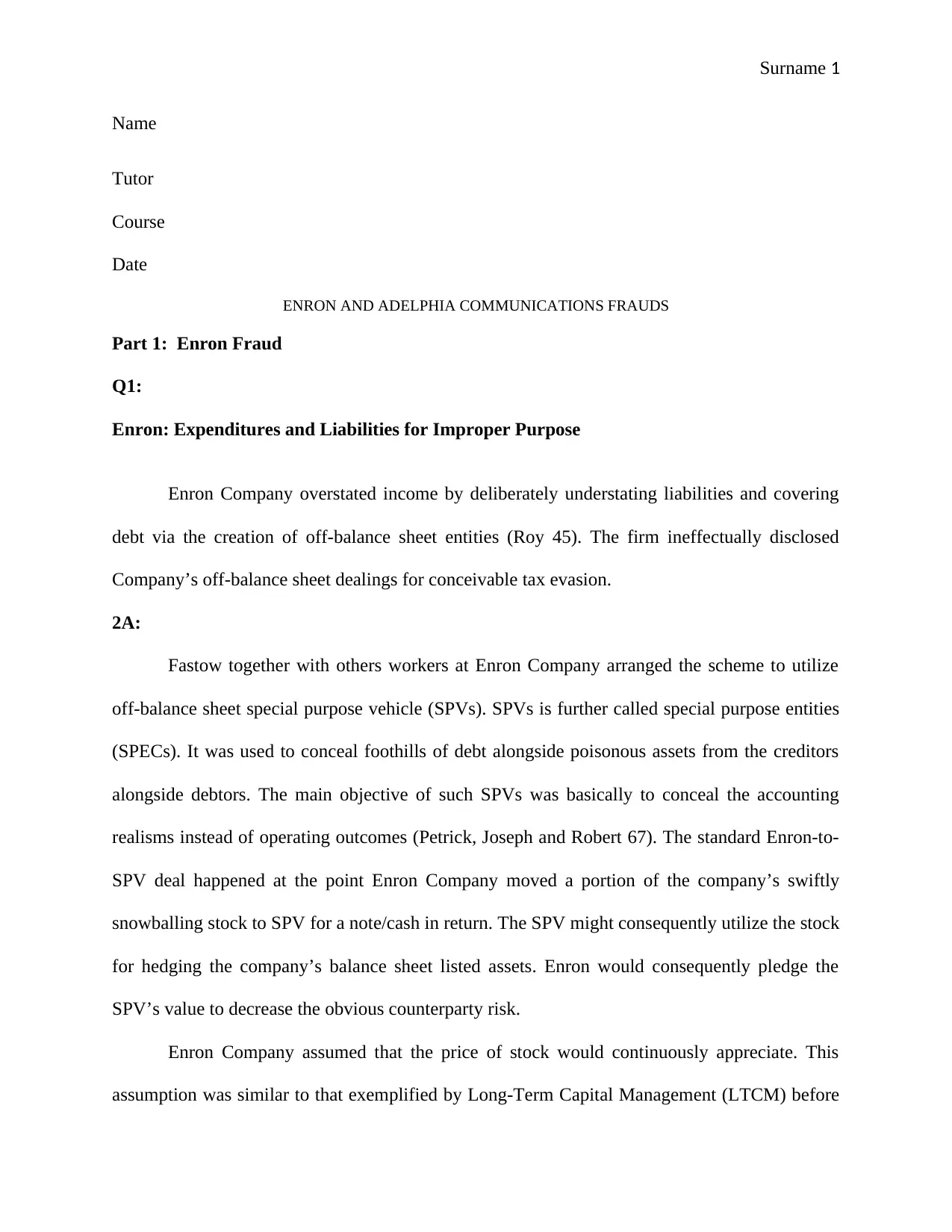
Surname 1
Name
Tutor
Course
Date
ENRON AND ADELPHIA COMMUNICATIONS FRAUDS
Part 1: Enron Fraud
Q1:
Enron: Expenditures and Liabilities for Improper Purpose
Enron Company overstated income by deliberately understating liabilities and covering
debt via the creation of off-balance sheet entities (Roy 45). The firm ineffectually disclosed
Company’s off-balance sheet dealings for conceivable tax evasion.
2A:
Fastow together with others workers at Enron Company arranged the scheme to utilize
off-balance sheet special purpose vehicle (SPVs). SPVs is further called special purpose entities
(SPECs). It was used to conceal foothills of debt alongside poisonous assets from the creditors
alongside debtors. The main objective of such SPVs was basically to conceal the accounting
realisms instead of operating outcomes (Petrick, Joseph and Robert 67). The standard Enron-to-
SPV deal happened at the point Enron Company moved a portion of the company’s swiftly
snowballing stock to SPV for a note/cash in return. The SPV might consequently utilize the stock
for hedging the company’s balance sheet listed assets. Enron would consequently pledge the
SPV’s value to decrease the obvious counterparty risk.
Enron Company assumed that the price of stock would continuously appreciate. This
assumption was similar to that exemplified by Long-Term Capital Management (LTCM) before
Name
Tutor
Course
Date
ENRON AND ADELPHIA COMMUNICATIONS FRAUDS
Part 1: Enron Fraud
Q1:
Enron: Expenditures and Liabilities for Improper Purpose
Enron Company overstated income by deliberately understating liabilities and covering
debt via the creation of off-balance sheet entities (Roy 45). The firm ineffectually disclosed
Company’s off-balance sheet dealings for conceivable tax evasion.
2A:
Fastow together with others workers at Enron Company arranged the scheme to utilize
off-balance sheet special purpose vehicle (SPVs). SPVs is further called special purpose entities
(SPECs). It was used to conceal foothills of debt alongside poisonous assets from the creditors
alongside debtors. The main objective of such SPVs was basically to conceal the accounting
realisms instead of operating outcomes (Petrick, Joseph and Robert 67). The standard Enron-to-
SPV deal happened at the point Enron Company moved a portion of the company’s swiftly
snowballing stock to SPV for a note/cash in return. The SPV might consequently utilize the stock
for hedging the company’s balance sheet listed assets. Enron would consequently pledge the
SPV’s value to decrease the obvious counterparty risk.
Enron Company assumed that the price of stock would continuously appreciate. This
assumption was similar to that exemplified by Long-Term Capital Management (LTCM) before
Secure Best Marks with AI Grader
Need help grading? Try our AI Grader for instant feedback on your assignments.
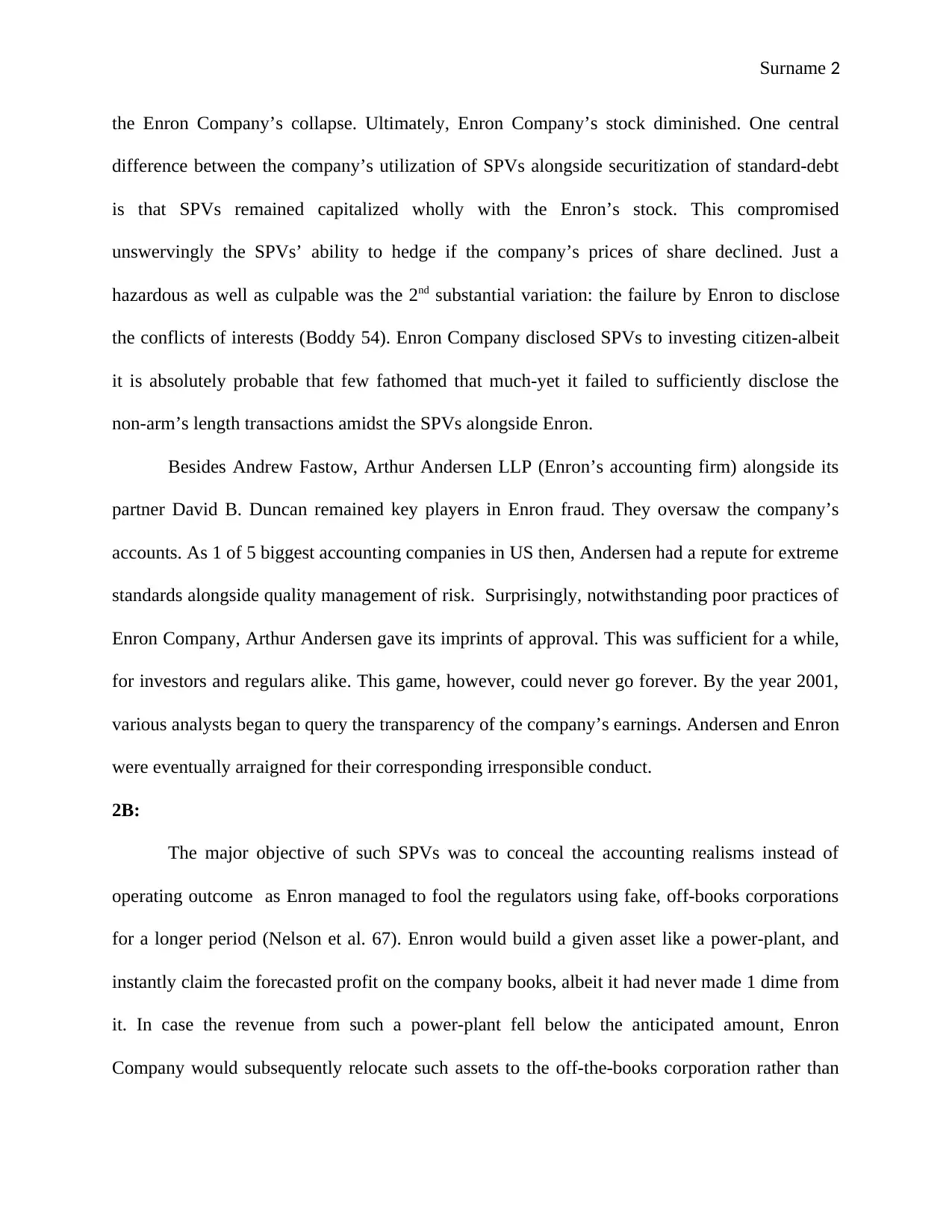
Surname 2
the Enron Company’s collapse. Ultimately, Enron Company’s stock diminished. One central
difference between the company’s utilization of SPVs alongside securitization of standard-debt
is that SPVs remained capitalized wholly with the Enron’s stock. This compromised
unswervingly the SPVs’ ability to hedge if the company’s prices of share declined. Just a
hazardous as well as culpable was the 2nd substantial variation: the failure by Enron to disclose
the conflicts of interests (Boddy 54). Enron Company disclosed SPVs to investing citizen-albeit
it is absolutely probable that few fathomed that much-yet it failed to sufficiently disclose the
non-arm’s length transactions amidst the SPVs alongside Enron.
Besides Andrew Fastow, Arthur Andersen LLP (Enron’s accounting firm) alongside its
partner David B. Duncan remained key players in Enron fraud. They oversaw the company’s
accounts. As 1 of 5 biggest accounting companies in US then, Andersen had a repute for extreme
standards alongside quality management of risk. Surprisingly, notwithstanding poor practices of
Enron Company, Arthur Andersen gave its imprints of approval. This was sufficient for a while,
for investors and regulars alike. This game, however, could never go forever. By the year 2001,
various analysts began to query the transparency of the company’s earnings. Andersen and Enron
were eventually arraigned for their corresponding irresponsible conduct.
2B:
The major objective of such SPVs was to conceal the accounting realisms instead of
operating outcome as Enron managed to fool the regulators using fake, off-books corporations
for a longer period (Nelson et al. 67). Enron would build a given asset like a power-plant, and
instantly claim the forecasted profit on the company books, albeit it had never made 1 dime from
it. In case the revenue from such a power-plant fell below the anticipated amount, Enron
Company would subsequently relocate such assets to the off-the-books corporation rather than
the Enron Company’s collapse. Ultimately, Enron Company’s stock diminished. One central
difference between the company’s utilization of SPVs alongside securitization of standard-debt
is that SPVs remained capitalized wholly with the Enron’s stock. This compromised
unswervingly the SPVs’ ability to hedge if the company’s prices of share declined. Just a
hazardous as well as culpable was the 2nd substantial variation: the failure by Enron to disclose
the conflicts of interests (Boddy 54). Enron Company disclosed SPVs to investing citizen-albeit
it is absolutely probable that few fathomed that much-yet it failed to sufficiently disclose the
non-arm’s length transactions amidst the SPVs alongside Enron.
Besides Andrew Fastow, Arthur Andersen LLP (Enron’s accounting firm) alongside its
partner David B. Duncan remained key players in Enron fraud. They oversaw the company’s
accounts. As 1 of 5 biggest accounting companies in US then, Andersen had a repute for extreme
standards alongside quality management of risk. Surprisingly, notwithstanding poor practices of
Enron Company, Arthur Andersen gave its imprints of approval. This was sufficient for a while,
for investors and regulars alike. This game, however, could never go forever. By the year 2001,
various analysts began to query the transparency of the company’s earnings. Andersen and Enron
were eventually arraigned for their corresponding irresponsible conduct.
2B:
The major objective of such SPVs was to conceal the accounting realisms instead of
operating outcome as Enron managed to fool the regulators using fake, off-books corporations
for a longer period (Nelson et al. 67). Enron would build a given asset like a power-plant, and
instantly claim the forecasted profit on the company books, albeit it had never made 1 dime from
it. In case the revenue from such a power-plant fell below the anticipated amount, Enron
Company would subsequently relocate such assets to the off-the-books corporation rather than
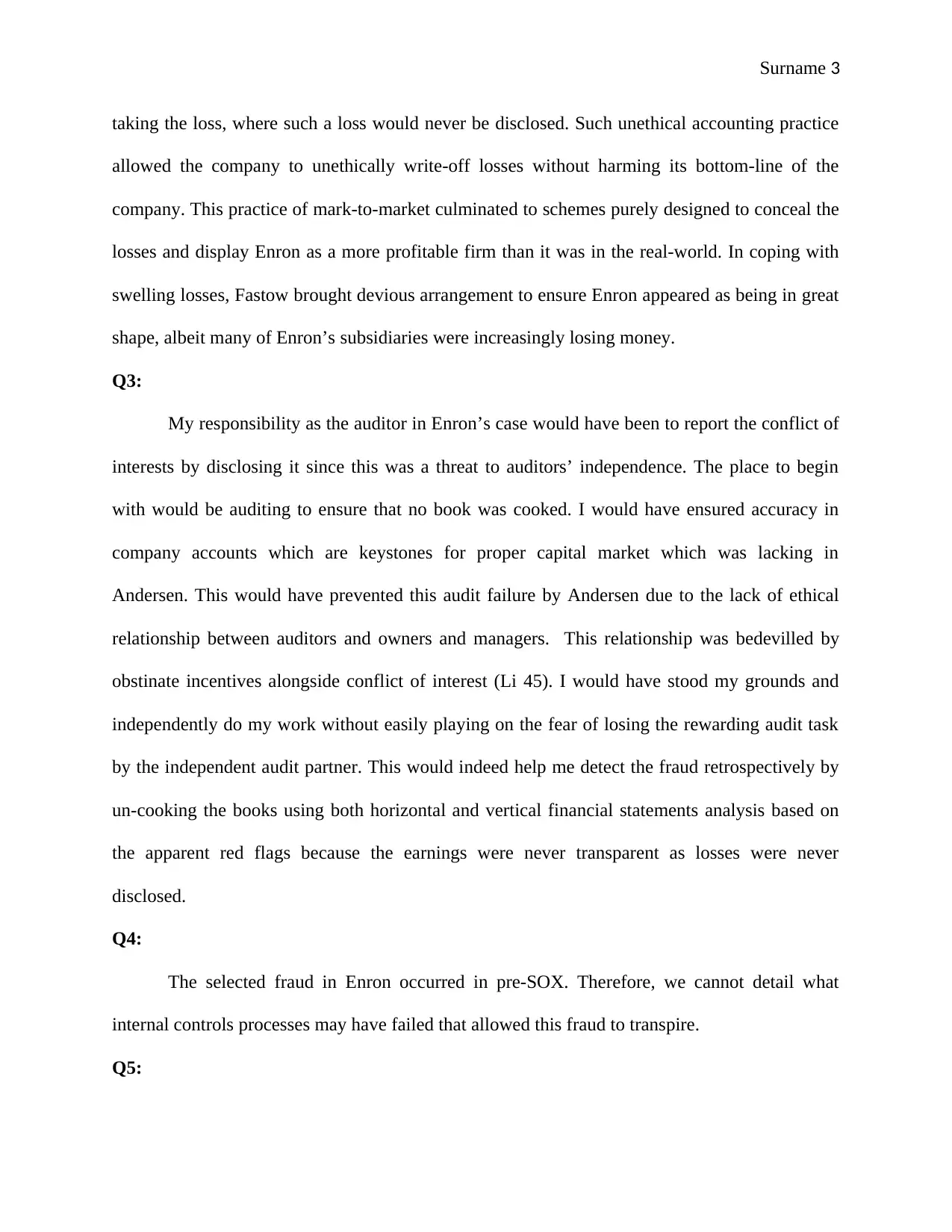
Surname 3
taking the loss, where such a loss would never be disclosed. Such unethical accounting practice
allowed the company to unethically write-off losses without harming its bottom-line of the
company. This practice of mark-to-market culminated to schemes purely designed to conceal the
losses and display Enron as a more profitable firm than it was in the real-world. In coping with
swelling losses, Fastow brought devious arrangement to ensure Enron appeared as being in great
shape, albeit many of Enron’s subsidiaries were increasingly losing money.
Q3:
My responsibility as the auditor in Enron’s case would have been to report the conflict of
interests by disclosing it since this was a threat to auditors’ independence. The place to begin
with would be auditing to ensure that no book was cooked. I would have ensured accuracy in
company accounts which are keystones for proper capital market which was lacking in
Andersen. This would have prevented this audit failure by Andersen due to the lack of ethical
relationship between auditors and owners and managers. This relationship was bedevilled by
obstinate incentives alongside conflict of interest (Li 45). I would have stood my grounds and
independently do my work without easily playing on the fear of losing the rewarding audit task
by the independent audit partner. This would indeed help me detect the fraud retrospectively by
un-cooking the books using both horizontal and vertical financial statements analysis based on
the apparent red flags because the earnings were never transparent as losses were never
disclosed.
Q4:
The selected fraud in Enron occurred in pre-SOX. Therefore, we cannot detail what
internal controls processes may have failed that allowed this fraud to transpire.
Q5:
taking the loss, where such a loss would never be disclosed. Such unethical accounting practice
allowed the company to unethically write-off losses without harming its bottom-line of the
company. This practice of mark-to-market culminated to schemes purely designed to conceal the
losses and display Enron as a more profitable firm than it was in the real-world. In coping with
swelling losses, Fastow brought devious arrangement to ensure Enron appeared as being in great
shape, albeit many of Enron’s subsidiaries were increasingly losing money.
Q3:
My responsibility as the auditor in Enron’s case would have been to report the conflict of
interests by disclosing it since this was a threat to auditors’ independence. The place to begin
with would be auditing to ensure that no book was cooked. I would have ensured accuracy in
company accounts which are keystones for proper capital market which was lacking in
Andersen. This would have prevented this audit failure by Andersen due to the lack of ethical
relationship between auditors and owners and managers. This relationship was bedevilled by
obstinate incentives alongside conflict of interest (Li 45). I would have stood my grounds and
independently do my work without easily playing on the fear of losing the rewarding audit task
by the independent audit partner. This would indeed help me detect the fraud retrospectively by
un-cooking the books using both horizontal and vertical financial statements analysis based on
the apparent red flags because the earnings were never transparent as losses were never
disclosed.
Q4:
The selected fraud in Enron occurred in pre-SOX. Therefore, we cannot detail what
internal controls processes may have failed that allowed this fraud to transpire.
Q5:
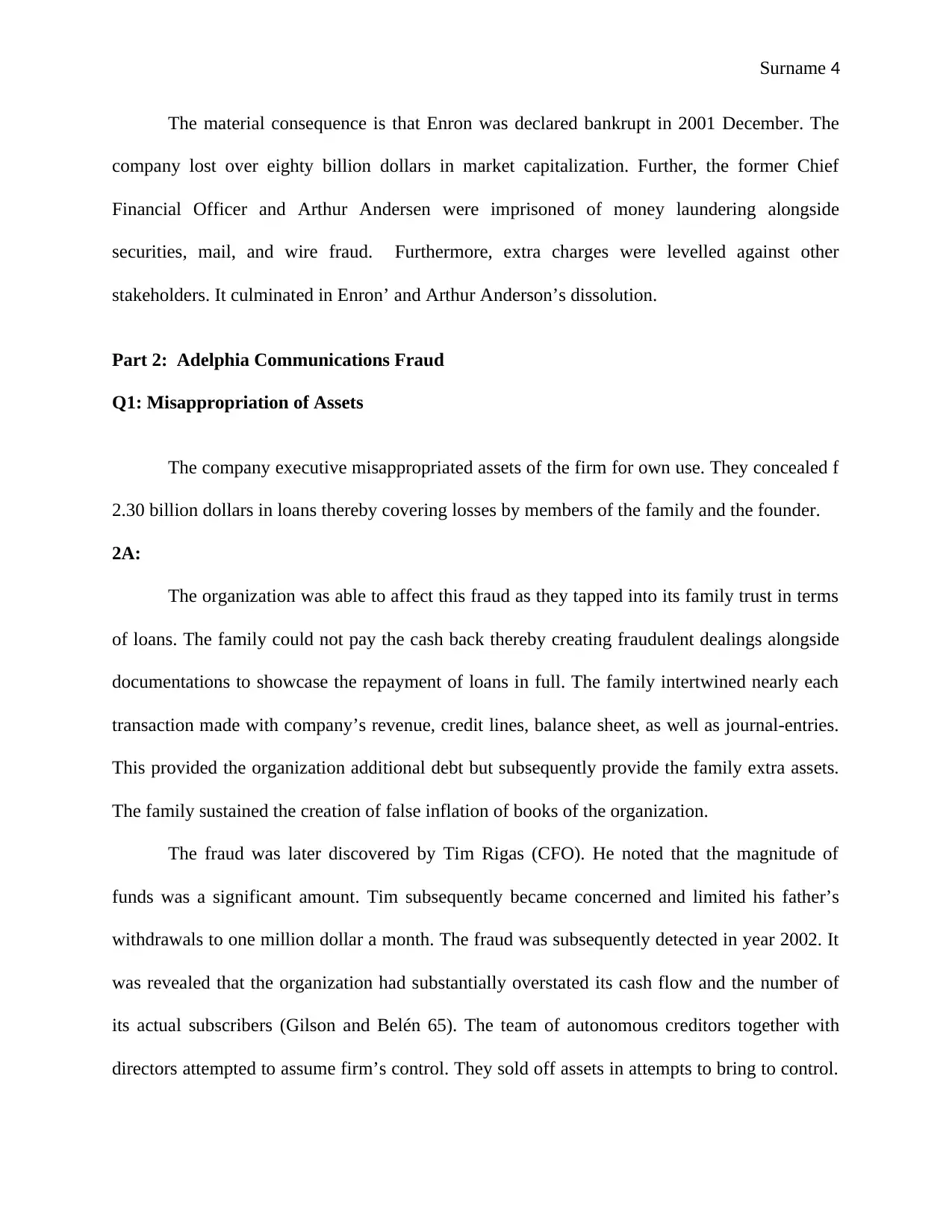
Surname 4
The material consequence is that Enron was declared bankrupt in 2001 December. The
company lost over eighty billion dollars in market capitalization. Further, the former Chief
Financial Officer and Arthur Andersen were imprisoned of money laundering alongside
securities, mail, and wire fraud. Furthermore, extra charges were levelled against other
stakeholders. It culminated in Enron’ and Arthur Anderson’s dissolution.
Part 2: Adelphia Communications Fraud
Q1: Misappropriation of Assets
The company executive misappropriated assets of the firm for own use. They concealed f
2.30 billion dollars in loans thereby covering losses by members of the family and the founder.
2A:
The organization was able to affect this fraud as they tapped into its family trust in terms
of loans. The family could not pay the cash back thereby creating fraudulent dealings alongside
documentations to showcase the repayment of loans in full. The family intertwined nearly each
transaction made with company’s revenue, credit lines, balance sheet, as well as journal-entries.
This provided the organization additional debt but subsequently provide the family extra assets.
The family sustained the creation of false inflation of books of the organization.
The fraud was later discovered by Tim Rigas (CFO). He noted that the magnitude of
funds was a significant amount. Tim subsequently became concerned and limited his father’s
withdrawals to one million dollar a month. The fraud was subsequently detected in year 2002. It
was revealed that the organization had substantially overstated its cash flow and the number of
its actual subscribers (Gilson and Belén 65). The team of autonomous creditors together with
directors attempted to assume firm’s control. They sold off assets in attempts to bring to control.
The material consequence is that Enron was declared bankrupt in 2001 December. The
company lost over eighty billion dollars in market capitalization. Further, the former Chief
Financial Officer and Arthur Andersen were imprisoned of money laundering alongside
securities, mail, and wire fraud. Furthermore, extra charges were levelled against other
stakeholders. It culminated in Enron’ and Arthur Anderson’s dissolution.
Part 2: Adelphia Communications Fraud
Q1: Misappropriation of Assets
The company executive misappropriated assets of the firm for own use. They concealed f
2.30 billion dollars in loans thereby covering losses by members of the family and the founder.
2A:
The organization was able to affect this fraud as they tapped into its family trust in terms
of loans. The family could not pay the cash back thereby creating fraudulent dealings alongside
documentations to showcase the repayment of loans in full. The family intertwined nearly each
transaction made with company’s revenue, credit lines, balance sheet, as well as journal-entries.
This provided the organization additional debt but subsequently provide the family extra assets.
The family sustained the creation of false inflation of books of the organization.
The fraud was later discovered by Tim Rigas (CFO). He noted that the magnitude of
funds was a significant amount. Tim subsequently became concerned and limited his father’s
withdrawals to one million dollar a month. The fraud was subsequently detected in year 2002. It
was revealed that the organization had substantially overstated its cash flow and the number of
its actual subscribers (Gilson and Belén 65). The team of autonomous creditors together with
directors attempted to assume firm’s control. They sold off assets in attempts to bring to control.
Secure Best Marks with AI Grader
Need help grading? Try our AI Grader for instant feedback on your assignments.
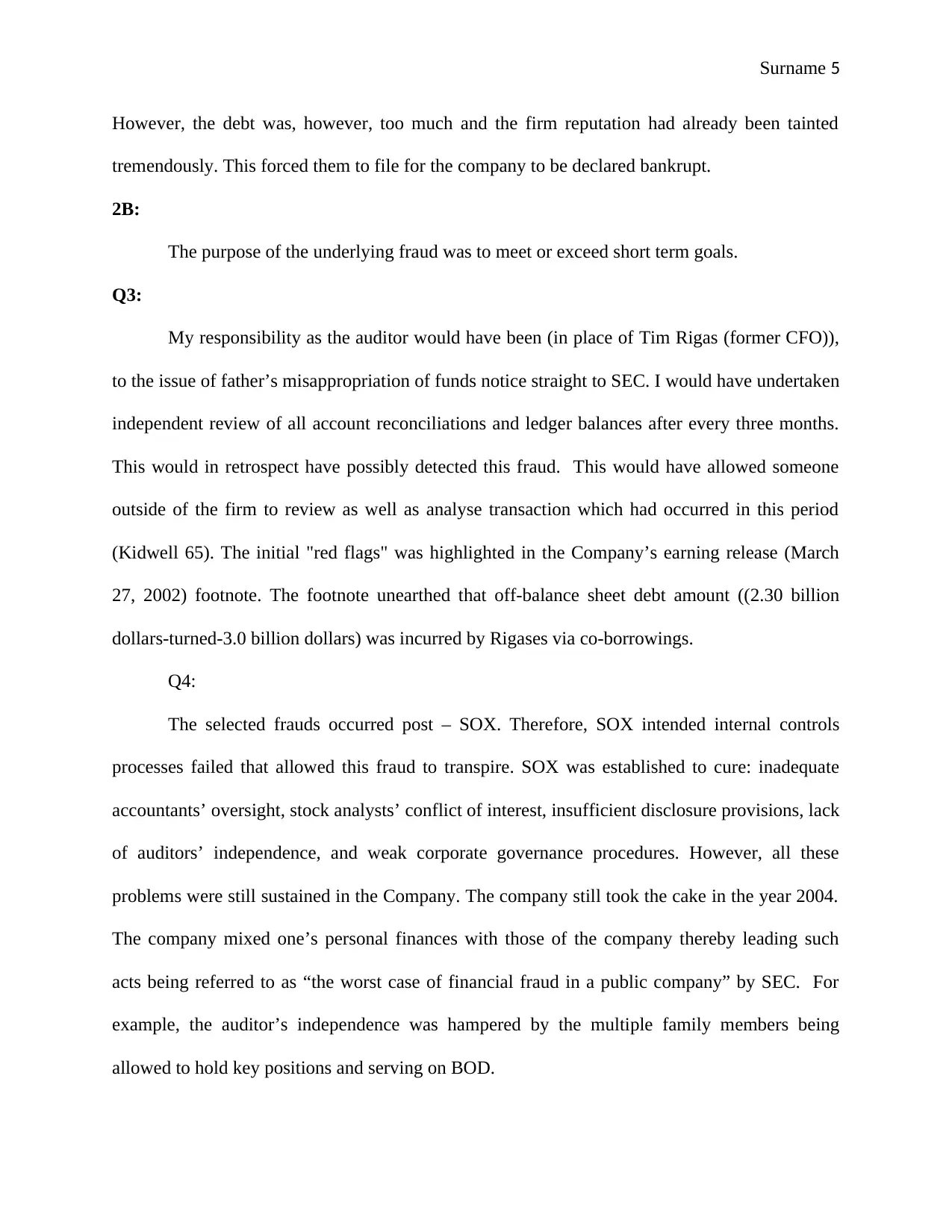
Surname 5
However, the debt was, however, too much and the firm reputation had already been tainted
tremendously. This forced them to file for the company to be declared bankrupt.
2B:
The purpose of the underlying fraud was to meet or exceed short term goals.
Q3:
My responsibility as the auditor would have been (in place of Tim Rigas (former CFO)),
to the issue of father’s misappropriation of funds notice straight to SEC. I would have undertaken
independent review of all account reconciliations and ledger balances after every three months.
This would in retrospect have possibly detected this fraud. This would have allowed someone
outside of the firm to review as well as analyse transaction which had occurred in this period
(Kidwell 65). The initial "red flags" was highlighted in the Company’s earning release (March
27, 2002) footnote. The footnote unearthed that off-balance sheet debt amount ((2.30 billion
dollars-turned-3.0 billion dollars) was incurred by Rigases via co-borrowings.
Q4:
The selected frauds occurred post – SOX. Therefore, SOX intended internal controls
processes failed that allowed this fraud to transpire. SOX was established to cure: inadequate
accountants’ oversight, stock analysts’ conflict of interest, insufficient disclosure provisions, lack
of auditors’ independence, and weak corporate governance procedures. However, all these
problems were still sustained in the Company. The company still took the cake in the year 2004.
The company mixed one’s personal finances with those of the company thereby leading such
acts being referred to as “the worst case of financial fraud in a public company” by SEC. For
example, the auditor’s independence was hampered by the multiple family members being
allowed to hold key positions and serving on BOD.
However, the debt was, however, too much and the firm reputation had already been tainted
tremendously. This forced them to file for the company to be declared bankrupt.
2B:
The purpose of the underlying fraud was to meet or exceed short term goals.
Q3:
My responsibility as the auditor would have been (in place of Tim Rigas (former CFO)),
to the issue of father’s misappropriation of funds notice straight to SEC. I would have undertaken
independent review of all account reconciliations and ledger balances after every three months.
This would in retrospect have possibly detected this fraud. This would have allowed someone
outside of the firm to review as well as analyse transaction which had occurred in this period
(Kidwell 65). The initial "red flags" was highlighted in the Company’s earning release (March
27, 2002) footnote. The footnote unearthed that off-balance sheet debt amount ((2.30 billion
dollars-turned-3.0 billion dollars) was incurred by Rigases via co-borrowings.
Q4:
The selected frauds occurred post – SOX. Therefore, SOX intended internal controls
processes failed that allowed this fraud to transpire. SOX was established to cure: inadequate
accountants’ oversight, stock analysts’ conflict of interest, insufficient disclosure provisions, lack
of auditors’ independence, and weak corporate governance procedures. However, all these
problems were still sustained in the Company. The company still took the cake in the year 2004.
The company mixed one’s personal finances with those of the company thereby leading such
acts being referred to as “the worst case of financial fraud in a public company” by SEC. For
example, the auditor’s independence was hampered by the multiple family members being
allowed to hold key positions and serving on BOD.
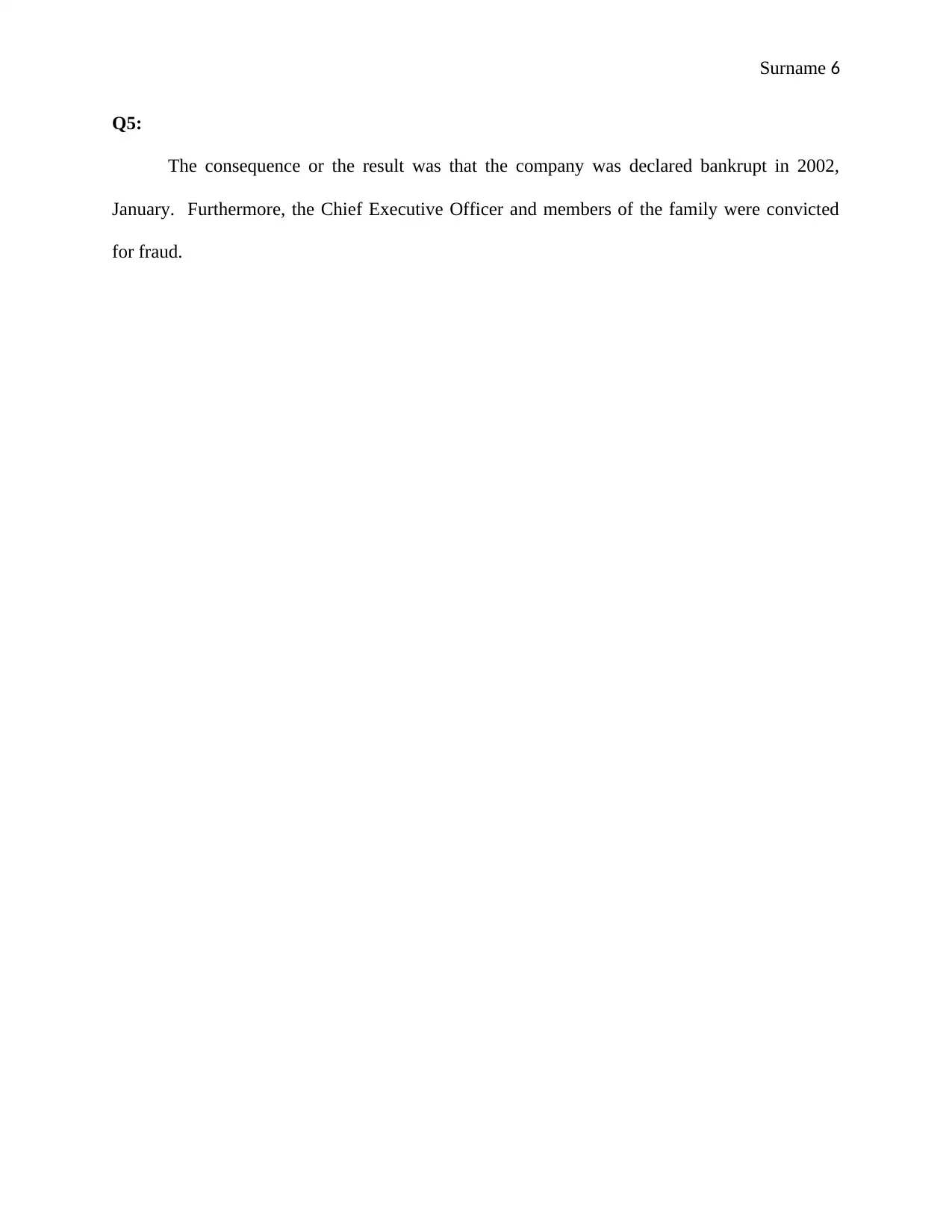
Surname 6
Q5:
The consequence or the result was that the company was declared bankrupt in 2002,
January. Furthermore, the Chief Executive Officer and members of the family were convicted
for fraud.
Q5:
The consequence or the result was that the company was declared bankrupt in 2002,
January. Furthermore, the Chief Executive Officer and members of the family were convicted
for fraud.
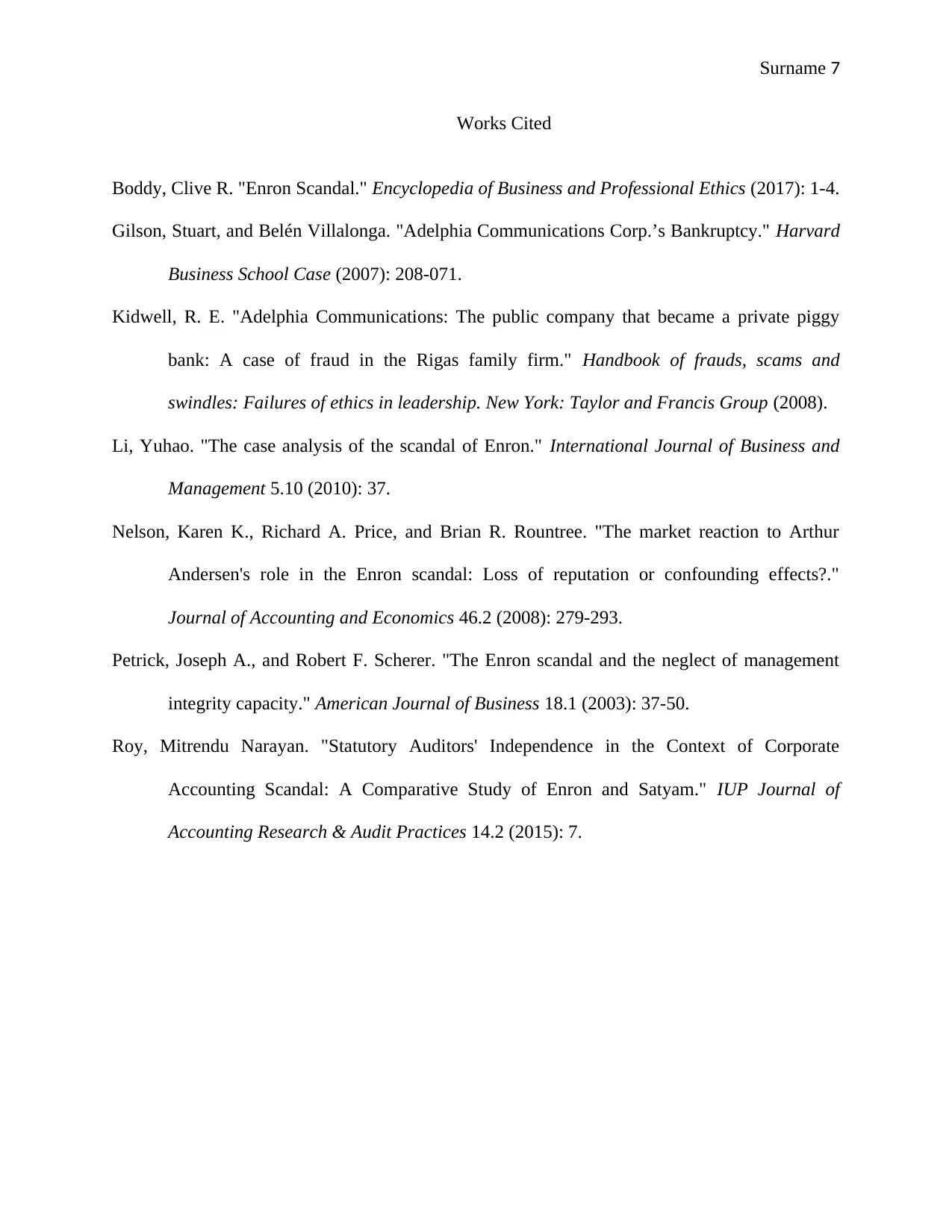
Surname 7
Works Cited
Boddy, Clive R. "Enron Scandal." Encyclopedia of Business and Professional Ethics (2017): 1-4.
Gilson, Stuart, and Belén Villalonga. "Adelphia Communications Corp.’s Bankruptcy." Harvard
Business School Case (2007): 208-071.
Kidwell, R. E. "Adelphia Communications: The public company that became a private piggy
bank: A case of fraud in the Rigas family firm." Handbook of frauds, scams and
swindles: Failures of ethics in leadership. New York: Taylor and Francis Group (2008).
Li, Yuhao. "The case analysis of the scandal of Enron." International Journal of Business and
Management 5.10 (2010): 37.
Nelson, Karen K., Richard A. Price, and Brian R. Rountree. "The market reaction to Arthur
Andersen's role in the Enron scandal: Loss of reputation or confounding effects?."
Journal of Accounting and Economics 46.2 (2008): 279-293.
Petrick, Joseph A., and Robert F. Scherer. "The Enron scandal and the neglect of management
integrity capacity." American Journal of Business 18.1 (2003): 37-50.
Roy, Mitrendu Narayan. "Statutory Auditors' Independence in the Context of Corporate
Accounting Scandal: A Comparative Study of Enron and Satyam." IUP Journal of
Accounting Research & Audit Practices 14.2 (2015): 7.
Works Cited
Boddy, Clive R. "Enron Scandal." Encyclopedia of Business and Professional Ethics (2017): 1-4.
Gilson, Stuart, and Belén Villalonga. "Adelphia Communications Corp.’s Bankruptcy." Harvard
Business School Case (2007): 208-071.
Kidwell, R. E. "Adelphia Communications: The public company that became a private piggy
bank: A case of fraud in the Rigas family firm." Handbook of frauds, scams and
swindles: Failures of ethics in leadership. New York: Taylor and Francis Group (2008).
Li, Yuhao. "The case analysis of the scandal of Enron." International Journal of Business and
Management 5.10 (2010): 37.
Nelson, Karen K., Richard A. Price, and Brian R. Rountree. "The market reaction to Arthur
Andersen's role in the Enron scandal: Loss of reputation or confounding effects?."
Journal of Accounting and Economics 46.2 (2008): 279-293.
Petrick, Joseph A., and Robert F. Scherer. "The Enron scandal and the neglect of management
integrity capacity." American Journal of Business 18.1 (2003): 37-50.
Roy, Mitrendu Narayan. "Statutory Auditors' Independence in the Context of Corporate
Accounting Scandal: A Comparative Study of Enron and Satyam." IUP Journal of
Accounting Research & Audit Practices 14.2 (2015): 7.
Paraphrase This Document
Need a fresh take? Get an instant paraphrase of this document with our AI Paraphraser

Surname 8
1 out of 8
Your All-in-One AI-Powered Toolkit for Academic Success.
+13062052269
info@desklib.com
Available 24*7 on WhatsApp / Email
![[object Object]](/_next/static/media/star-bottom.7253800d.svg)
Unlock your academic potential
© 2024 | Zucol Services PVT LTD | All rights reserved.


